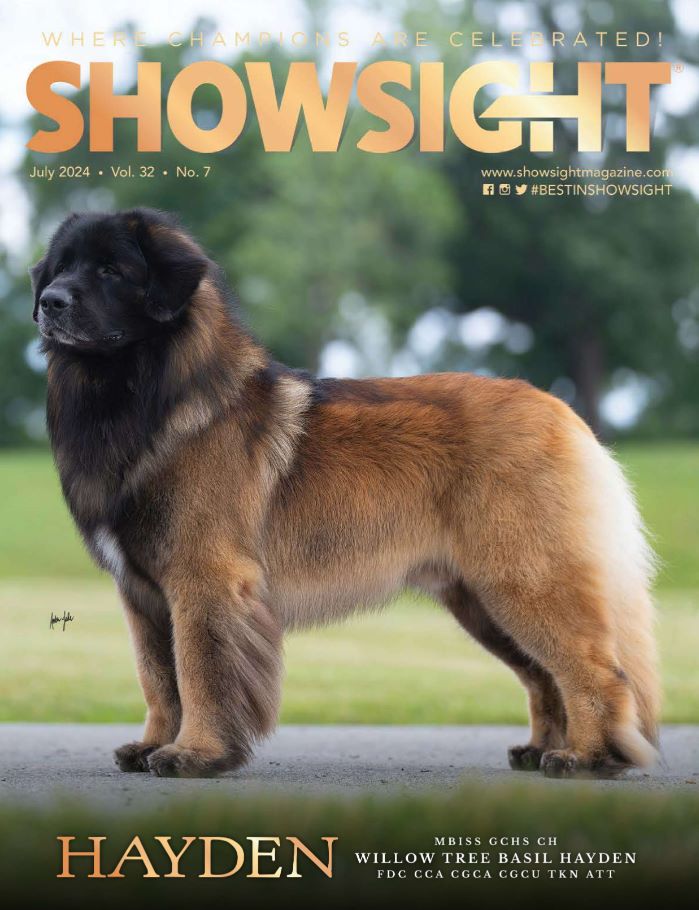As a judge, I have gained a great deal of perspective by watching exhibitors present their dogs in the ring. While my intention is always to choose the dog that I feel best represents the standard of that breed, there are several variables that enter into the final decision.
Hopefully, this discussion will encourage you to take a closer look at what you are currently doing and realize that there may be adjustments that you can make that will bring you greater rewards. As it is often said, if you don’t change what you’re doing, you won’t get a different result. If you are looking for a different result, a better result, read on.
Personal History
In my own personal history, I did just that. I learned to find a new direction which eventually brought me to a better place. In the early years of my thirty-plus year history as a breeder/owner/handler, I found my initial success with Rottweilers. After about fifteen years, I felt the desire to add a different breed to my household. I wanted a dog that would get along with my Rottweilers, so I started an exhaustive study of other breeds that appealed to me.
The first breed I entertained was the Norfolk Terrier. I was told by the foremost breeder in the United States that this “could end badly, since little Terriers tend to challenge other dogs without any consideration for their own small size.” Then I explored my fondness for the tousled look of the PBGV. Upon a close examination of the standard, I noticed the descriptive phrase “gives tongue freely” and gulped at the thought of adding a noisy dog to my already vocal pack. This is when I learned that, when researching a breed, it’s important to read the entire standard and have open discussions with experienced breeders and owners of that breed.
What about a Whippet? I loved the look of the breed, and I thought that they would be so much fun to show. I discussed getting a Whippet with a prominent East Coast breeder. I told her that my dogs were allowed to run loose in the woods for an hour or two every morning on my wooded property in Vermont. She gently told me that, with a great deal of training, I might be able to teach a Whippet the recall. I understood. It would be spotty at best. So much for that idea.
With much time and thought invested, and not having found a suitable breed, I spent time watching different Groups to find more candidates for my new breed. I started noticing Sussex Spaniels. They were candid. They had a sense of humor unto themselves. They were personable and genuinely sweet dogs. I watched the Sussex in the Group for two years before deciding that this would be the breed that I would add to my household. My Sussex was an amazing dog to live with and great fun to learn to show. With this breed, I had to learn grooming techniques not required for the breeds I had owned previously. They were also far easier to train and show than the Working breeds I had shown. It was truly a great match for me!
None of My Business
While it is none of my business what breed of dog you choose to breed and show, I would be less than honest if I were to say that I have never stood in the middle of the ring and wondered why someone chose their breed. I have, as have my fellow judges, pondered this subject.
If you are in the ring exhibiting a dog, presumably you are making your best effort to win. To that end, your dog must be presented in a style that best matches the criteria in the breed standard. From my perspective, the two most obvious problems are when the exhibitor cannot move the dog in a way that demonstrates its breed-specific gait or when the exhibitor is unable to maintain the dog in appropriate show coat.
Returning our thoughts to the Rottweiler, in many of my judging assignments, I have had to select between two nearly equal dogs. In all breeds, I focus on breed-specific movement, and that is especially important in Working breeds. The Rottweiler is a trotting breed that requires some length of stride, without excessive speed. If the exhibitor of one of the dogs cannot move their dog appropriately to exhibit proper gait, at times, I am forced to point to the dog whose handler is able to move with the dog as a team.
Judges cannot be expected to overlook a critical part of the standard, movement, when it is not presented effectively. If your dog requires a different gait than you are capable of, then perhaps it’s time to reevaluate the breed which you have selected to show. (I can feel the recoil now from the reader.)
Why Add Another Breed?
Nevertheless, if you are committed to being an owner handler, love the competition, and have developed a group of friends who also show dogs, what do you do? The obvious answer is adding another breed to your household. In my own search for an additional breed, I discovered a breed of dog that I enjoyed as a companion and show dog. My patience and determination paid off. My experience with the Sussex Spaniel was a complete success, and set the stage for me to have an open mind about adding another breed: the Tibetan Terrier.
With the AKC now registering 200 breeds, it should not be difficult to find a breed that fits your personality and lifestyle, and one that is perfectly suited for your abilities as an exhibitor. As a judge, I see talented handlers who could do a great deal of winning with different breeds that need a more athletic handler, but they continue to exclusively show their “heart breed.”
On the other hand, maybe you are very athletic and would look fantastic in the ring with an elegant dog, but you currently show a breed that moves more slowly, perhaps even one that “lumbers.” You might enjoy adding a different breed that uses your abilities more effectively. You just might find a breed that fits your personality and lifestyle that is more suited to your abilities as an exhibitor.
Are You Open to Change?
Oftentimes exhibitors will look for a different breed for various reasons; however, some exhibitors are not capable of making a change. I’ve seen that become a detriment to their owner handler careers.
Sometimes, heart wins out over head. In many cases, the primary consideration is investment in a breed. Dog people invest time, energy, money, and ego. There is plenty of opportunity for change, though. A Poodle person can develop a passion for Terriers or Tibetan Spaniels. A Rottweiler breeder can turn into a Tibetan Terrier breeder/owner/handler, or a Clumber Spaniel breeder can be a preservation breeder of Welsh Springer Spaniels, Sussex Spaniels, and English Toy Spaniels. You may recognize some of these examples and grow as a dog person, as in these examples.
For some people, adding a totally different breed can make life easier. When I acquired a Sussex Spaniel, I had already lived with numerous breeds, but he was (and still is) the easiest and most fun breed I’ve ever owned and showed.
Dog people choose breeds for a lot of different reasons. However, an original breed doesn’t have to be the only breed. My own willingness to step back from what I was doing and look in a new direction, the experiences that I have shared here, have helped me in ways that I could not have imagined at the time.
Showing numerous Working breeds gave me breadth in the Group and an understanding of how to approach dogs with comfortable confidence as a judge. Showing Samoyeds gave me an understanding of the importance of coat quantity, texture, and quality. Showing my Sussex gave me the experience of showing an achondroplastic breed of quiet and soulful temperament, and a coat that I had to learn to work in a new way. These experiences have given me additional knowledge in understanding breed-specific qualities and the ability to judge dogs to their standard.









